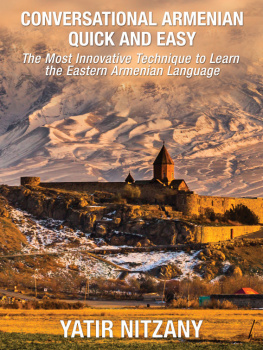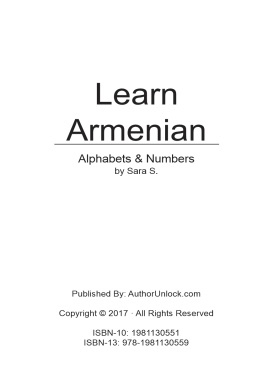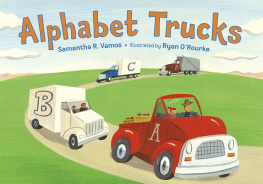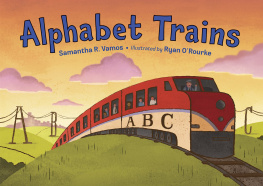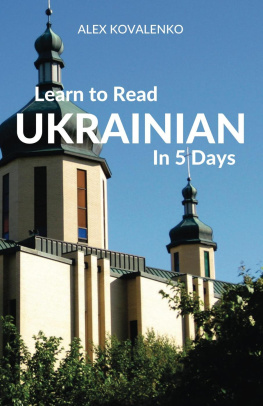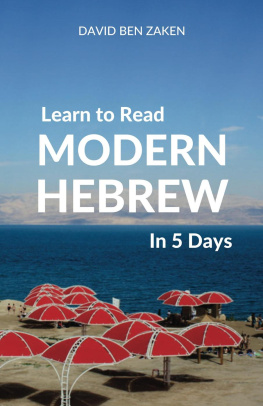Learn to Read Armenian in 5 Days By: Alex Hakobyan Published by Wolfedale Press Copyright 2015 All rights reserved. No part of this publication may be reproduced, distributed, or transmitted in any form or by any means, including photocopying, recording, or other electronic or mechanical methods, without the prior written permission of the publisher. The cover image of Khor Virap Monastery in Armenia is licensed under cc by-sa 3.0. Author: Andrew Behesnilian www.AndrewSevag.com www.wolfedalepress.com
TABLE OF CONTENTS
INTRODUCTION
L earning a new alphabet can be very intimidating for an English speaker only used to reading the Latin alphabet. This is partly why English speakers tend to stick to learning other languages that use the same alphabet, such as French, Spanish and Italian because they seem a lot easier! But learning a new alphabet does not have to be so difficult. The difficulty is finding a good system to learn the new alphabet so that the student does not get discouraged and give up before making any real progress.
Making progress in the language is the best motivator. The secret to learning a new alphabet is to be taught each letter separately, and then to practice how the new letters combine with letters you already know to read real words in the language in a structured way. This is not revolutionary it is probably how you learned to read English but it is not easy to find for other languages. This book will teach you how to read the Armenian alphabet in exactly that way, and with this method you will be able to read Armenian in only 5 days or less! After that you will be able to enjoy the Armenian language and culture in a way that you were never able to before. THE ARMENIAN ALPHABET The Armenian alphabet contains 39 letters and is written from left to right. The alphabet was introduced around 405 AD by Mesrop Mashtots, an Armenian linguist and ecclesiastical leader.
The Armenian alphabet is graphically unique it does not closely resemble any other alphabet but there are some noticeable similarities with the Greek alphabet. It is only used to write the Armenian language. Although it does not resemble the Latin alphabet used to write English (and other European languages) it is not a difficult alphabet to learn to read. This is because, with very few exceptions, letters are pronounced as they are written and written as they are pronounced, unlike languages such as English that make use of a lot of silent letters and historical spellings. Like the Latin alphabet used to write English, the Armenian alphabet has both upper- and lowercase letters. Uppercase letters are used at the beginning of a sentence and in proper nouns.
There are, however, two different standard versions of the Armenian language, Eastern Armenian and Western Armenian. Eastern Armenian is the official and most widely spoken language in the Republic of Armenia, as well as the Armenian communities in Iran and Russia. Western Armenian was originally spoken in modern day Turkey during the Ottoman Empire, but is now almost exclusively spoken by Armenians in the diaspora and is classified as an endangered language. This course uses the standard pronunciation and spelling of Eastern Armenian. The differences between Eastern and Western Armenian are largely a matter of accent and regular pronunciation changes; the alphabet is identical. For those interested in Western Armenian, see the section of this book titled Differences Between Eastern and Western Armenian.
HOW TO USE THIS COURSE The primary goal of this course book is to teach the reader to recognize the Armenian alphabet and to begin to read the Armenian language. The main way this is accomplished is by teaching the individual pronunciations of each letter, and then utilizing Practice sections where the student can practice reading real Armenian words. These Practice sections are very important and the main way the student will start to feel comfortable with the Armenian alphabet. The answers to all Practice questions are included directly below the questions, but try to avoid looking at the answers until you have attempted to answer the questions yourself. Throughout the book, the reader will also learn approximately 150 real Armenian words. These words have been carefully selected to be of maximum benefit to beginner students of the language and are a great starting point for students who want to continue their study of Armenian.
In the end of the book there are two glossaries one in thematic order and one in alphabetical order where the student can study and memorize all the words learned in this course. The course material has been designed to be completed slowly over 5 days, while reviewing lessons as necessary. You are encouraged to go at whatever pace you feel comfortable with and to feel free to go back to lessons to review as much as needed. Good luck and I hope you enjoy the first step on your journey to learning the Armenian language.
UNIT 1 - , , ,
T he first letter introduced in this course is the Armenian letter . The pronunciation of this letter resembles the a sound in the English words spa and father (IPA: //).
The letter in its lowercase form resembles a handwritten English w. The uppercase form is . The letter is pronounced like the English p in pear and Peter (IPA: /p/). Notice that this letter resembles but with a longer tail that continues below the line. The uppercase form is . Try to read the Armenian word below: It is of course papa, which means the same as papa or daddy in English.
The letter is pronounced like the English m in mother or Mary (IPA: /m/). This letter resembles a handwritten u with a hook on the top right side. The uppercase form is . Try to read the Armenian word below: This is the Armenian word mama, which means the same as mama or mommy in English. The last letter of this unit is the letter . It is pronounced like the English n in now or Nancy (IPA: /n/).
The letter resembles the letter , but with the hook on the left side of the u instead of the right side. The uppercase form is . PRACTICE Try to recognize these English words in their Armenian disguises. The answers are below. ANSWERS 1. map 3. nap 4. man 5. man 5.
Nana
UNIT 2 - , , ,
T he letter is pronounced like the ee in tree, or the i in spaghetti (IPA: /i/). It will be represented by i in this book. The letter resembles the English letter h with the left side continuing below the line. The uppercase form is . The letter is pronounced like the k sound in keep or Kim (IPA: /k/). The letter looks almost like a handwritten 4 or the letter turned upside down.
The uppercase form is . The letter is pronounced like the t sound in tin or Tim (IPA: /t/). The letter resembles a u and an n stuck together. The uppercase form is , which resembles an uppercase S in English. The letter is pronounced like the s sound in some or Sam (IPA: /s/). The letter resembles the English letter u.
The uppercase form is . TRY NOT TO CONFUSE The letters , , and are easily confused. Practice differentiating between , which sounds like s, which sounds like n and which sounds like m. PRACTICE Try to recognize these English words in their Armenian disguises. Focus on the correct pronunciation and not necessarily the English spelling. The answers are below.
ANSWERS 1. see 2. tea 3. me 4. keep 5. peek 7. steam 8. camp 9. scam 10. stamp
UNIT 3 - , , , ,
T he Armenian letter is pronounced like the o sound in hope or rope (IPA: /o/). stamp
UNIT 3 - , , , ,
T he Armenian letter is pronounced like the o sound in hope or rope (IPA: /o/).
The letter usually is used at the beginning of a word in Armenian. The Armenian letter looks and sounds just like the o in the English alphabet. The uppercase form is . In the middle or the end of a word, the same o sound is spelled with the letter instead of . The letter resembles the letter n in English. with a v sound and an o sound. with a v sound and an o sound.
Next page


